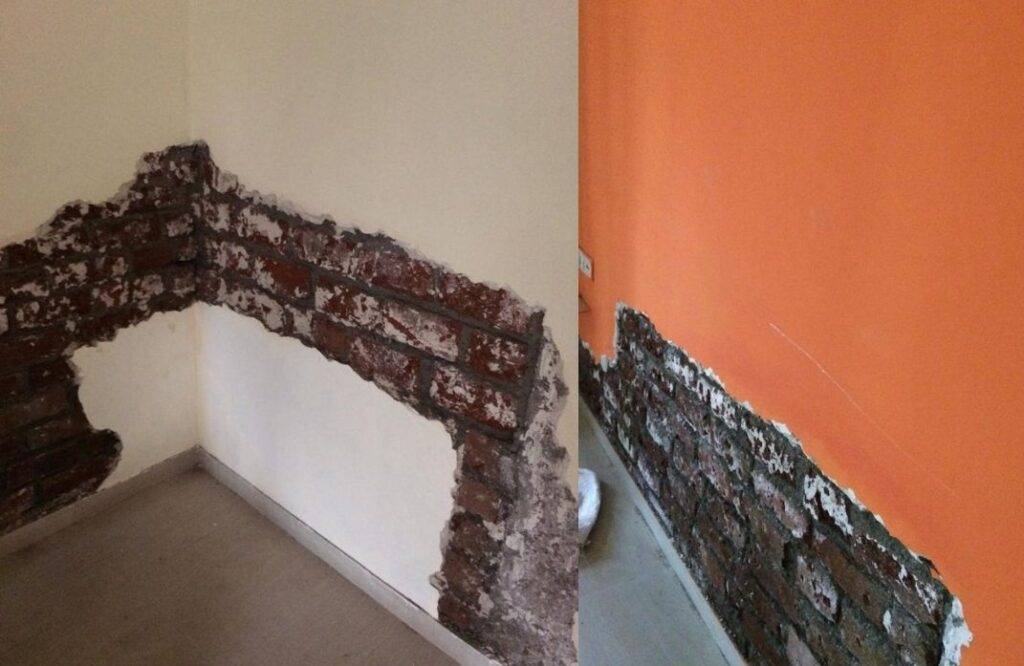Home Leakage Solutions
Wall Dampness from the floor level
Dampness in the wall is a common occurrence in most buildings, especially near the skirting at floor level. Wall dampness is initially ignored and later takes the shape of a full-blown problem of dampness up to 3’0” which is now within the range of our view especially when we are seated.
Ways to trace it – flaking paint, peeling wallpaper, a “musty” odor, and timber decay are among the most common symptoms of rising damp.
Images of dampness from the floor:
Threefold solution based on the inspection in wet rooms as follows:
1. Checking all water supply lines using ultrasonic gadgets.
2. Inspect all drain lines using a thermal scanner.
3. Inspecting all tile joints using moisture meter.
Treatment of damp walls based on survey involves solving leakages in plumbing lines.
Water supply and drain, floor tile joint filling.
and
Injection grouting is based on the extent of seepage through open joints and hollowness within tiled surfaces
And finally, replastering of the affected wall surfaces by removing existing plaster, coating the wall (brick-block) with cementitious polymer coating, providing injection grouting if required and replastering the surface.

Ceiling Leakages at home or office space
There can be several reasons for the leakages from the ceiling, the presence of wet-room or planters is the most common source of perennial leakages in the buildings.
It is important to thoroughly understand the pattern of leakage which can be done using the thermography process.
This in turn helps us to identify the source of leakage as visible in the affected areas. Resolving the leakage is only like joining the dots based on the actual issues of the lower floor and the corresponding source points in the upper floors/s. Leakage sources including adjacent areas may be contributing to the overall leakage in the affected ceilings.
These can be resolved by joint filling on the floor above and doing PU Injection grouting from the affected ceiling.

Wet Room Leakage Solutions
Wet Rooms include Bathrooms, Kitchens and Open balcony with planters. These leakages are commonly seen as these spaces remain wet for quite some time in the day. Inferior material and improper workmanship are primary reasons for this. You could notice damp spots or visible droplets on the ceiling or walls of your home, especially if there is a bathroom or a kitchen on the floor above or a second-floor bathroom in your own home. Bungalows, apartments or condos, this problem can come in unannounced so how does one prepare for it?
Common causes for these leakages and solutions offered
1.Bathroom wall tiles/Kitchen Tiles or Open Balcony:
This is a primary cause of these leakages, generally caused by improper tile grout. Powdered grout generally used isn’t waterproof since it is porous and moisture can be easily absorbed. The previous faulty grout should be scraped out and a waterproof formulation should be applied and later grout sealer should be applied as a finishing touch. Wherever there is void created in the flooring, this can be cured by injected chemical under pressure, which fills up all the voids. Watch our video:
Water Piping System:
Old and rusted water pipes can cause these leaks, especially when they are concealed in the walls. Metal pipes can rust over a period of time and as the pipe walls get damaged, they can lead to pipe bursts which can lead to a leakage. The leakage may not be noticed immediately if the pipes are concealed and by this time the damage may have already been done.
Floor tiles:
When grouts wear off from floor tiles, leaks are bound to happen, similar to bathroom wall tiles. This is an extremely common cause of wet room leakages. In order to prevent this, it is suggested to use clear penetrative waterproofing treatment which allows non-drilling and non-invasive approach. It is also extremely effective since chemicals can easily penetrate into the gaps and create a waterproof boundary that doesn’t allow water ingress. In case the leakage needs to be repaired from your house itself, then PU injection treatment can be done.
